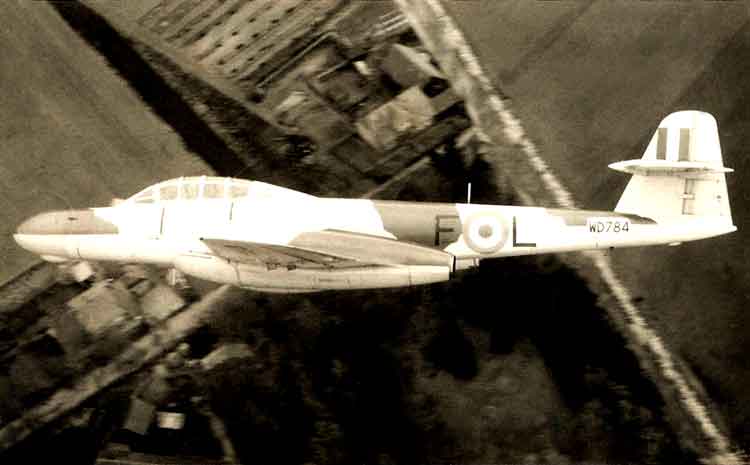
|
||
|
Mike Wraight being taken for a ride in the back seat of a Meteor NF.11 from Ahlhorn, showing the Ahlhorn boys the way to the Fassberg range. - about 53. David Watkins kindly tells me that they were from 96 Sqn. (Thanks to Mike Wraight.) Gloster Meteor Apart from the fact that it was jet-powered, the Gloster Meteor was entirely conventional in design. It served the Royal Air Force and other air forces until more advanced equipment came along in the 1950s. The Gloster Meteor was the Allies' first operational jet-fighter, and was Gloster's answer to Air Ministry specification F.9/40, calling for a single-seat interceptor powered by gas turbine engines. The low thrust output of the engines available at the time dictated a twin-engined configuration. Twelve prototypes were ordered and eight were completed, the first flying on 5 March 1943. The aircraft was powered by two 680 Kg (1,500 lb) thrust Halford H.1 turbojets, but the first 20 production aircraft were fitted with the 771 Kg (1,700 lb) Rolls-Royce Welland. Twelve of these were issued to No. 616 Squadron, which began operational patrols against V-1 flying bombs in July 1944. The Squadron flew Meteors until August 1945, when it disbanded. Re-formed in 1947, it operated Mosquitos and then Meteor Mks 3, 4 and 8 before disbanding for the last time in 1957. The second variant to enter squadron service, the Meteor F.Mk.3, was a much better proposition than the F.Mk.1 as it used the 906 Kg (2,000 lb) thrust Rolls-Royce Derwent 1 engine; however, delivereies to No. 616 Squadron did not begin until December 1944. The Mk.3 version which eventually equipped 15 squadrons of RAF Fighter Command in the immediate post-war years, and which had been operationally tested in a ground-attack role in Belgium with Nos. 616 and 504 Squadrons in the closing weeks of the war, was followed into service by the Meteor F.Mk.4. Powered by two Rolls-Royce Derwent Vs, the F.Mk.4 first flew in April 1945 and subsequently, in November, set up a new world air speed record of 975 km/h (606 mph). The Meteor F.Mk.5 was a photo-reconnaissance version of the Mk.4, only a few were built. The Mk.6 was a swept-wing Meteor project that never left the drawing board, while the T.Mk.7 was a two-seat trainer variant, of which 640 were built. [Click to see Pilots' Notes.] This version was used by most 2TAF squadrons as their training aircraft until it was replced by the Vampire T.11. To improve the range and performance of the F.4, Gloster designed a new high-speed tail unit, lengthened the forward fuselage, installed an extra internal fuel tank and introduced a one-piece sliding cockpit canopy over a Martin Baker ejection seat, the modified aircraft emerging as the Meteor F.Mk.8 in October 1948. The F.8 was the most prolific of the Meteor variants and formed the mainstay of RAF Fighter Command in the early 1950s, equipping 32 regular and 11 R.Aux.AF squadrons. The Metoer F.8, which was supplied to both Egypt and Israel, saw considerable action during the Arab-Israeli war of 1956; it was also used by No. 77 Squadron RAAF in Korea, where it proved to be greatly inferior to the Mig-15 but excelled in the ground-attack role. The Meteors FR.9 and FR.10 were reconnaissance variants, while the 'long-nosed' Meteor NF.11, in this photo, NF.12, NF.13 and NF.14 were ASI-equipped night-fighters. The NF.14, the last of the Meteor fighters, had a new clear-vision cockpit canopy, and deliveries to the RAF were completed in 1955. In October 1955, Flight Refuelling Ltd began the conversion of a number of ex-RAF Meteor F.8s as target aircraft, 233 being converted between 1956 and 1969 with the designation U.Mk.15 and U.Mk.16. A further batch was converted for use by the RAAF with the designation U.Mk.21. The Meteor TT.20, converted from the NF.11, was a target tug. SPECIFICATIONS: For Meteor F.Mk.3: Crew: 1; Powerplant: two 906 Kg (2,000 lb) thrust Rolls-Royce Derwent 1 turbojet engines. Performance: max speed 675 km/h (415 mph); range 1,580 km (988 miles); service celiing: 13,106 m (43,000 ft); Dimensions: wingspan: 13.10m (43 ft); length: 12.50 m (41ft 3 in); height: 3.96m (13 ft); Weight: 6,314 kg (13,920 lb) loaded; Armamemnt: four 20mm (0.79 in) Hispano cannon. (Thanks to The Encyclopedia of Aircraft from Silverdale Books.) |
||